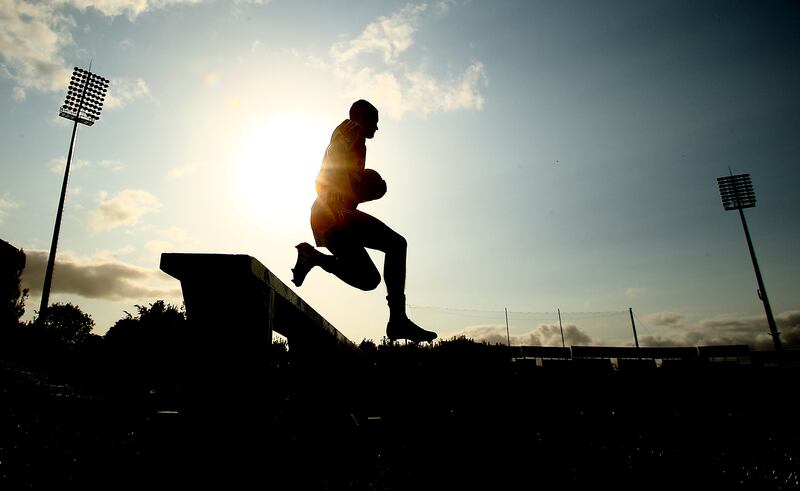The GAA decided a long, long time ago that knock-out championships are king and so we can become inured to the fact that they are incredibly cut-throat. You are denied the clarity of a league table — if you played 15 or 20 games, you’d have a fair idea yourself where you lay in the pecking order. With a knock-out championship, even if it’s only for the last three or four stages, you can always point to one day when the wheels fell off the wagon.
Maybe it was all that you deserved from the year, and maybe it wasn’t. Either way, there are no spaces left for explanations in the margins of a championship bracket.
And nowhere are defeats weighted with more finality than in the minor grade. It is the end of juvenile football or hurling for an entire cohort of young men and women, and when the end comes, it’s not just the end of the year, but the end of your GAA childhood, the end of your apprenticeship, and the break-up of that particular group of friends you may have been with from the age of six or seven.
After minor, the best one or two might move straight on to a senior club side, the next four or five might be brought into a club’s second team, and then inevitably, a few will be lost to the game completely
One of the most impactful things I’ve ever heard a GAA coach say was Liam Griffin telling his victorious Wexford team in the dressingroom after the All-Ireland final in 1997 that they would never be together again as a squad exactly as it was composed that day. Things change, things fall apart. It’s true in adult dressingrooms, but it’s much more true at minor level.
After minor, the best one or two might move straight on to a senior club side, the next four or five might be brought into a club’s second team, and then inevitably, a few will be lost to the game completely. These are not always, or not even often, the players you expect to lose – but that’s natural. Real life gets in the way.
Like everything else, you very seldom get the dream send-off. Some of my best friends in football were in charge of the Templeogue Synge Street minor teams, and both A and B teams fell at the quarter-final stage in Dublin on Sunday morning.
At the other end of the M6, the Athenry hurlers won the Galway county minor A title, extending a run from under-13 where the lads in their final year of each grade hoovered up every title available to them — under-13, under-14, under-15, Féile, under-16 and now minor, which is under-17 in Galway. My nephew Enda started at midfield in every one of those county finals, and we couldn’t be more proud of him, and his team-mates.

Success on that scale is incredibly rare, and Templeogue Synge Street wouldn’t be alone in not having anything like a comparable level of success. But the differences between their situation and the situation in Galway are indicative of a wider imbalance.
Galway brought minor down to under-17 to be in line with the intercounty minor grade. Dublin have kept minor at under-18, and so for my friends in charge of their own children’s age group, this year was a year where they leapt straight from playing under-16 in 2023 to combine their talents with the second-year minors, the 18-year-olds in the group. To finish the job with the lads they started with as a group, they will have 2025.
Galway have felt the need to protect the minor grade, to decouple it entirely from adult competition — the rule at national level being that you can’t play adult games until the year you turn 18.
There is a comfort in training with the same group of lads every week for 10 years
Second-year minors (that is 18-year-olds) have been playing for the Synge Street second, third and fourth teams in adult competition this summer, and it’s been useful to give them experience of adult football, so that now they’ve finished up in minor, they at least have an idea of the dressingroom they could go into next year.
This is the part that clubs have to try to get right, but it’s not easy. There is a comfort in training with the same group of lads every week for 10 years. Asking those kids to leave that comfort behind and step into adult dressingrooms is not a gimme.
And the GAA still hasn’t quite figured out the best way to bridge the gap between minor and senior. Even the word “minor” means different things in different counties. Cork and Dublin have more clubs than any other county, but they (and others) have both kept minor at 18, in defiance of the change to under-17 that was made at intercounty level in 2017.
Galway can’t even decide where the next grade should begin and end. The county’s footballers have an under-19 competition, the hurlers have an under-20 competition. In Dublin, it’s still under-21 for football and hurling. In US political parlance, the GAA have thrown this one back to the states, and it’s led to a fair degree of confusion.
Either way, the challenge remains to ensure that minors have somewhere to go to when the curtain falls on their juvenile career. Even for those lucky enough to end on a winning note, these don’t have to be the best days of their GAA lives.

















